February 13, 2018
This is the fifth entry in the Education Leader’s Guide to Reading Growth, a 7-part series that explores reading practice, reading growth, and the factors that matter most for student reading success.
What is the key to long-term reading success?
By now, we hope we’ve convinced you that increasing high-quality reading practice is crucial to students’ long-term success in reading. But how do you, in turn, convince your students, especially those who are struggling in reading, to engage in that high-quality reading practice?
Motivation is the key.
It makes sense that students who are motivated to read will read more. One study even found that motivation, not past reading history, was a better predictor of a student’s current and future volume and breadth of reading.1 The authors concluded that motivation increases reading frequency, rather than reading frequency causing an increase in motivation. In other words, to get our students reading, we have to motivate them first.
The effect of motivation on reading achievement: What does the research say?
If motivation affects reading practice, how does it affect reading achievement?
Two separate studies have examined the “temporal-interactive effect” that a positive attitude toward reading has on reading achievement. This means motivation interacts more and more with achievement as time goes on. And even if motivation does not seem to affect a student’s current reading achievement, it may have a significant impact on their future reading achievement.
Even if motivation does not seem to affect a student’s current reading achievement, it may have a significant impact on their future reading achievement.
The first study found that a student’s attitude toward reading at the beginning of third grade was not significantly related to their reading achievement in second and third grades.
Achievement in third grade was the best predictor of achievement in seventh grade, which is not surprising given the cumulative nature of learning. However, a student’s reading attitude at the beginning of third grade also had significant power in forecasting reading achievement in the spring of seventh grade — almost five years later!2
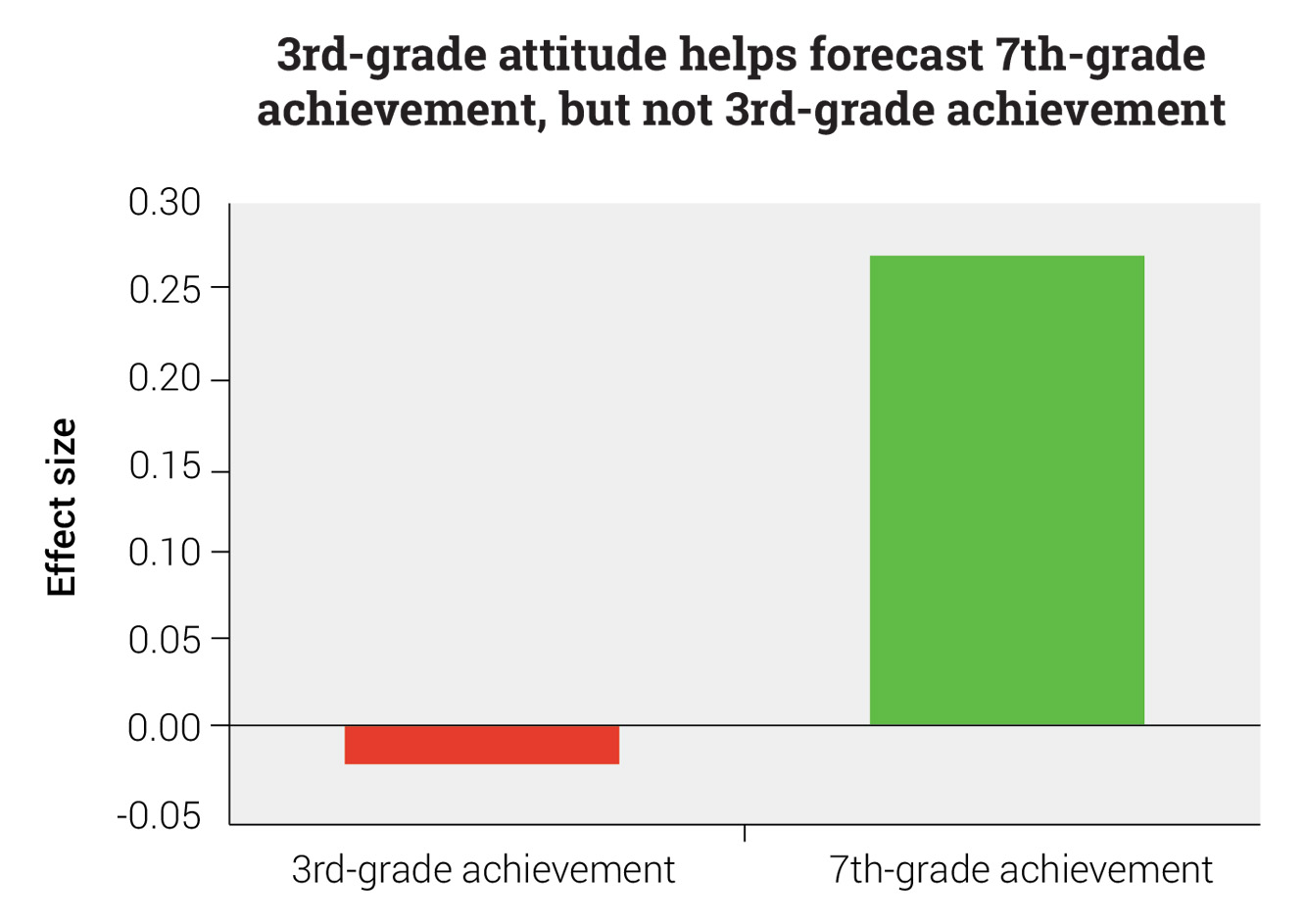
The study’s authors proposed that the relationship between reading attitude and reading achievement is both complex and long-term. Thus, in early elementary grades, there may be little or no correlation. The connection then grows over time and by early adolescence reading attitude turns into an important causal determinant of reading achievement.
The second study looked at slightly older students. It found a significant positive relationship between reading attitudes in fourth grade and reading achievement in fourth and fifth grades.3 The authors suggested that reading attitudes and reading achievement are significantly related by the time students enter the upper elementary grades—matching the first study’s suggestion that the relationship between the two grows closer over time.
The strongest attitude-achievement correlation was between a student’s reading attitude in fourth grade and their achievement in fifth grade, indicating there is a more powerful relationship between current motivation and future achievement than between current motivation and current achievement.
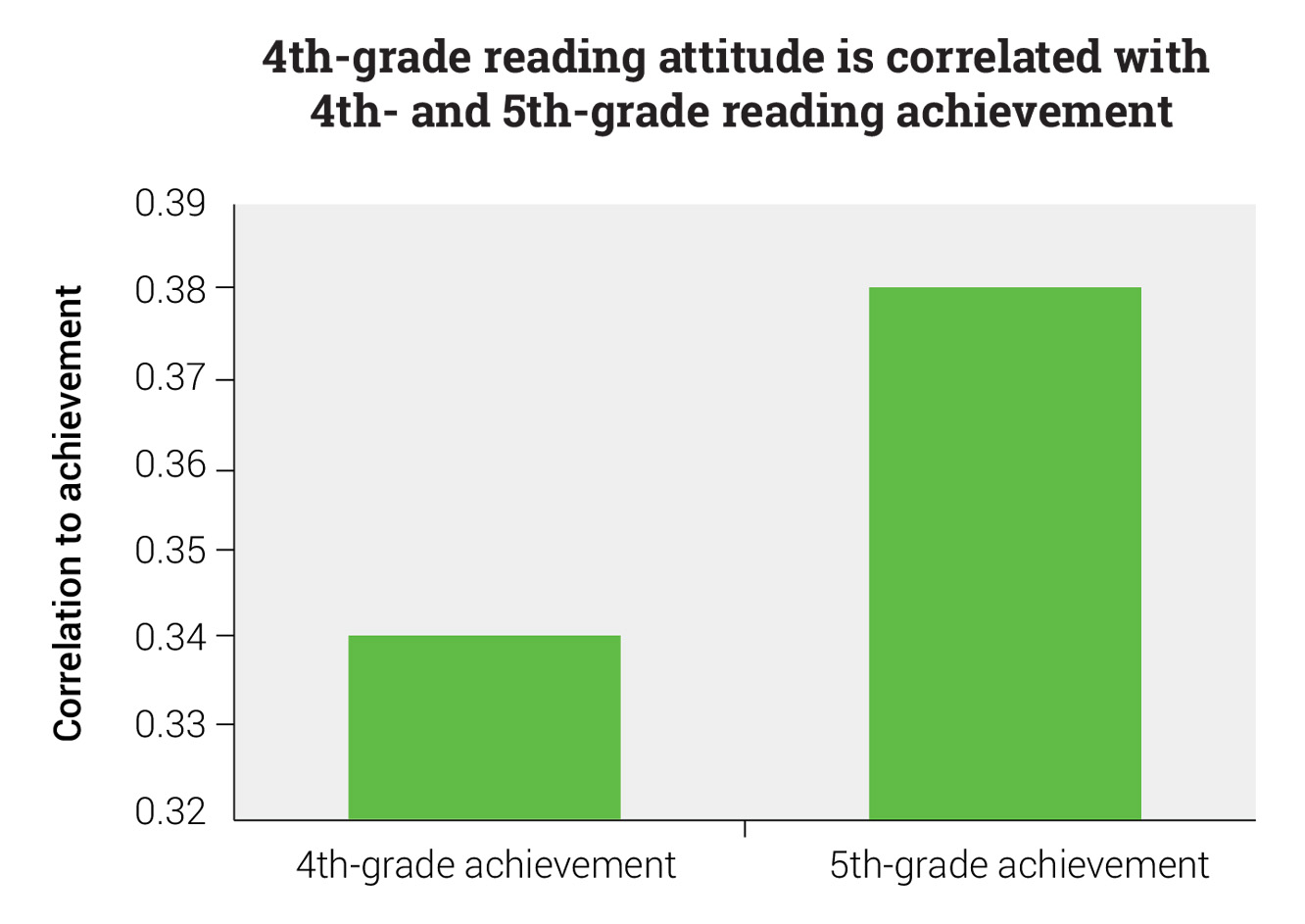
What can be learned from these studies? We’d suggest two key takeaways:
- It is important to motivate students to read, even if we cannot detect any immediate impact on achievement. The biggest effects might not be seen until months or even years later.
- Motivation gets more important as students age, not less, so keeping students motivated to read in middle and high school is essential.
3 steps to motivate reading practice
Following are three interrelated strategies for encouraging all students to read more.
#1: Identify what we want students to do
First, we must identify the reading activities and behaviors that we want to promote among students. In other words—what does high-quality reading practice look like?
Thankfully, we’ve already done the work for the first step. As detailed in our second and third blog posts, we know exactly what we want students to do. We want them to spend more time reading. We want them to read a variety of texts within their Zone of Proximal Development (ZPD). And we want them to put effort into their reading.
#2: Identify what success looks like
Second, we have to decide how much of those activities and behaviors are needed. What does success look like?
Before we dive into this aspect of reading motivation, let us emphasize that success may look different for every student. Instead of defaulting to grade-level expectations, we suggest setting personalized goals in reading for students.
#3: Set personalized goals for student reading practice
Third, we need to set multiple reading goals for each student, based on reading time, reading materials, and student effort.
Reading time
The first personalized goal we want to set is around reading time. We know students should be reading at least 15 minutes a day in order to avoid slowed growth, so that is an excellent starting point. However, when we’re considering reading goals for struggling readers and other students who need additional growth, we might want to increase the goal to 20, 30, or even 60 minutes of daily practice.
An educator should rely on their expertise and knowledge of the student as well as any assessment data they have (including growth history) to judge which time goal is most appropriate for each student’s individual needs.
Reading materials
The second personalized goal we want to set is around reading materials. We know the reader profile with the highest average reading achievement is the one that is diversified in long and complex texts. This means we want our students to read a healthy number of texts of varying lengths, including:
- Books
- Newspaper articles
- Magazine features
- Graphic novels
We also know that below-ZPD (Zone of Proximal Development) reading is associated with slowed growth, so we want most of those titles to be within or above a student’s ZPD.
Remember that each student will have a unique ZPD based on their individual reading level, and that their ZPD will change as they learn and grow. The goal of having the majority of texts be “within or above ZPD” will stay the same throughout a child’s schooling. But what is and isn’t “within or above ZPD” will change from year to year and even during the course of the school year.
Once again, educators should rely on their knowledge and expertise to decide how much reading should be within the student’s ZPD. Note that below-ZPD texts should not be banned entirely.
Student effort
The third personalized goal we want to set is around effort.
This might seem to be the hardest of the goals for reading to set and monitor, but it’s actually not. As discussed in our fourth blog post, literal comprehension is connected to effort. High literal comprehension is a strong sign that a student is putting effort into their work. On the other hand, it may also be a sign that a student is reading texts that are too easy, so keep an eye out for students who always score 100%.
However, be very cautious when scores indicate low literal comprehension. It may be a sign of low effort, but it may also be a sign that:
- A student’s ZPD is set too high
- They’ve chosen a text that’s too hard
- They need more instruction around reading skills or comprehension strategies
- They do not have the background knowledge or vocabulary required to understand a specific text
Consider literal comprehension to be a reflection of both the student’s effort and the teacher’s instruction. High literal comprehension signals that multiple factors are all coming together and growth is being accelerated. But if just one factor is missing, whether on the student’s or teacher’s end, then low literal comprehension might be the result.
Set a goal that students maintain high literal comprehension. We recommend 85% or higher to support accelerated growth. When students fall below that goal, be sure to thoroughly investigate the cause before making decisions or taking action.
What are some examples of reading goals for struggling readers?
As you might expect, goals in reading will look different depending on the age of the student. For example, the personalized reading goals for struggling readers in the 2nd-grade may include things such as:
- Reading for a certain number of minutes each evening
- Participating in the summer reading club at their local library
- Narrating what they’ve read back to a parent or teacher
In the upper grades, a list of reading goals for struggling readers may have the students aiming to:
- Keep a reading journal
- Read a specific number of nonfiction books
- Read a book by a new author each month
- Read all the books in a favorite series
Encourage students to choose one or two goals for reading each month or until they are able to demonstrate mastery. Once they reach their goal, build on their success by having them select a new goal. On the other hand, if they struggle with a specific goal, collaborate with them to create a new strategy to achieve the goal.
By working with students to set personalized reading goals, educators are helping them create a purpose for reading that can last a lifetime.
Identify key motivational factors
A key factor in how to motivate high-quality reading practice is to look at what makes students more likely to reach their personalized goals. What are the key motivational factors in helping them want to read?
Personalized goals as reading motivation
Now that we’ve defined high-quality reading practice and set goals, how do we motivate students to reach those goals? The good news is that you’ve already started! Personalized goal setting is a very powerful motivational tool.
A study that took a close-up look at the reading practice habits and achievement of more than 4.2 million students in grades 1–12 discovered students who had personalized goals in reading read more and achieved better outcomes. It found that students who had personalized goals that were set as part of a research-based reading practice program:
- Read 35% more minutes per day
- Read more difficult books; and
- Had 4% higher literal comprehension scores than students who used the same program but without set goals
It shouldn’t be surprising then that the students with personalized goals for reading also experienced higher reading achievement growth.4
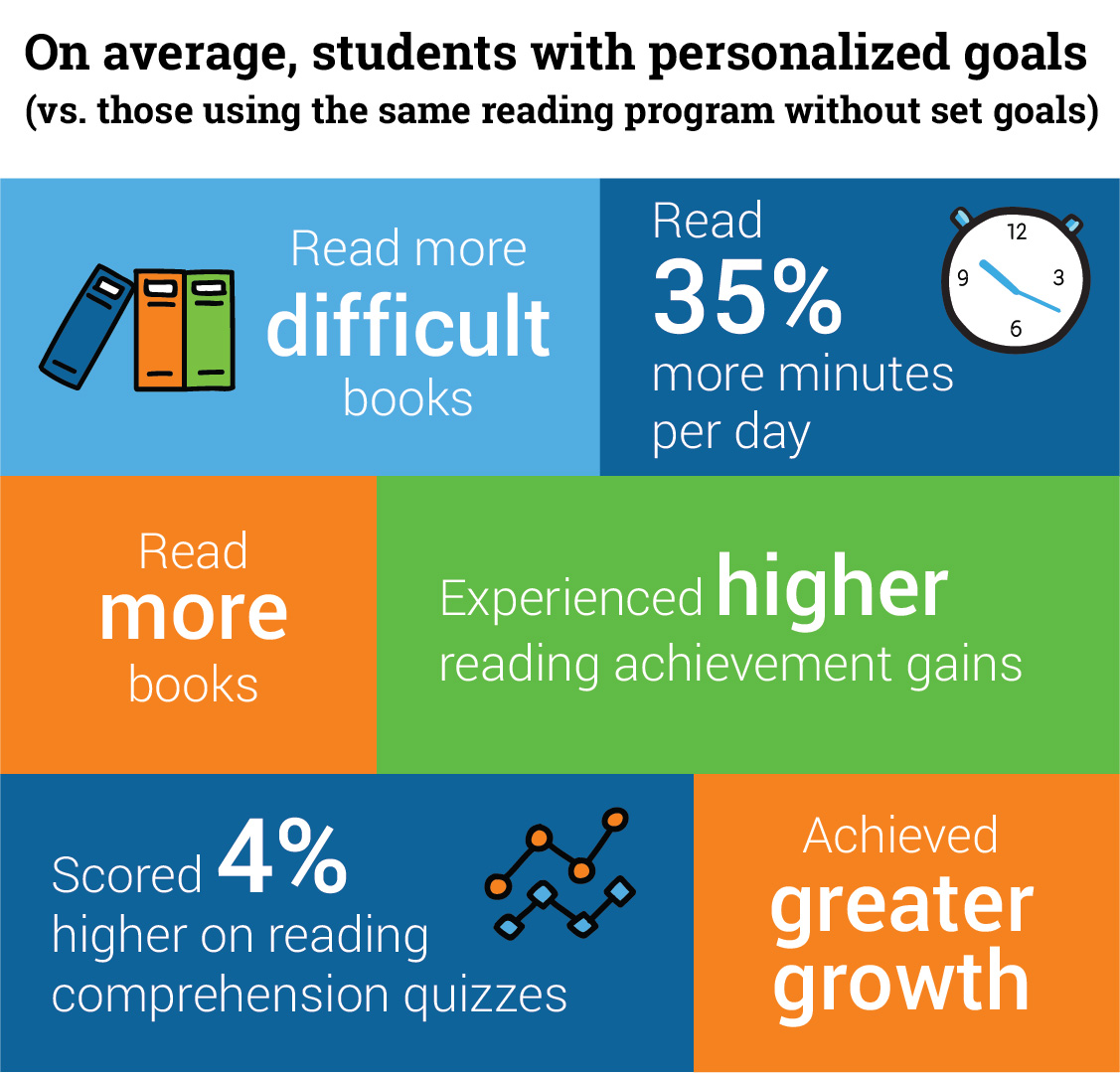
Surveys reveal multiple dimensions of motivation
What other factors help motivate high-quality reading practice? Many.
Motivation is a huge topic—so huge that one could dedicate an entire library to the subject. For example, a study examining 11 different dimensions of reading motivation found that all of them had statistically significant correlations with reading activity.5
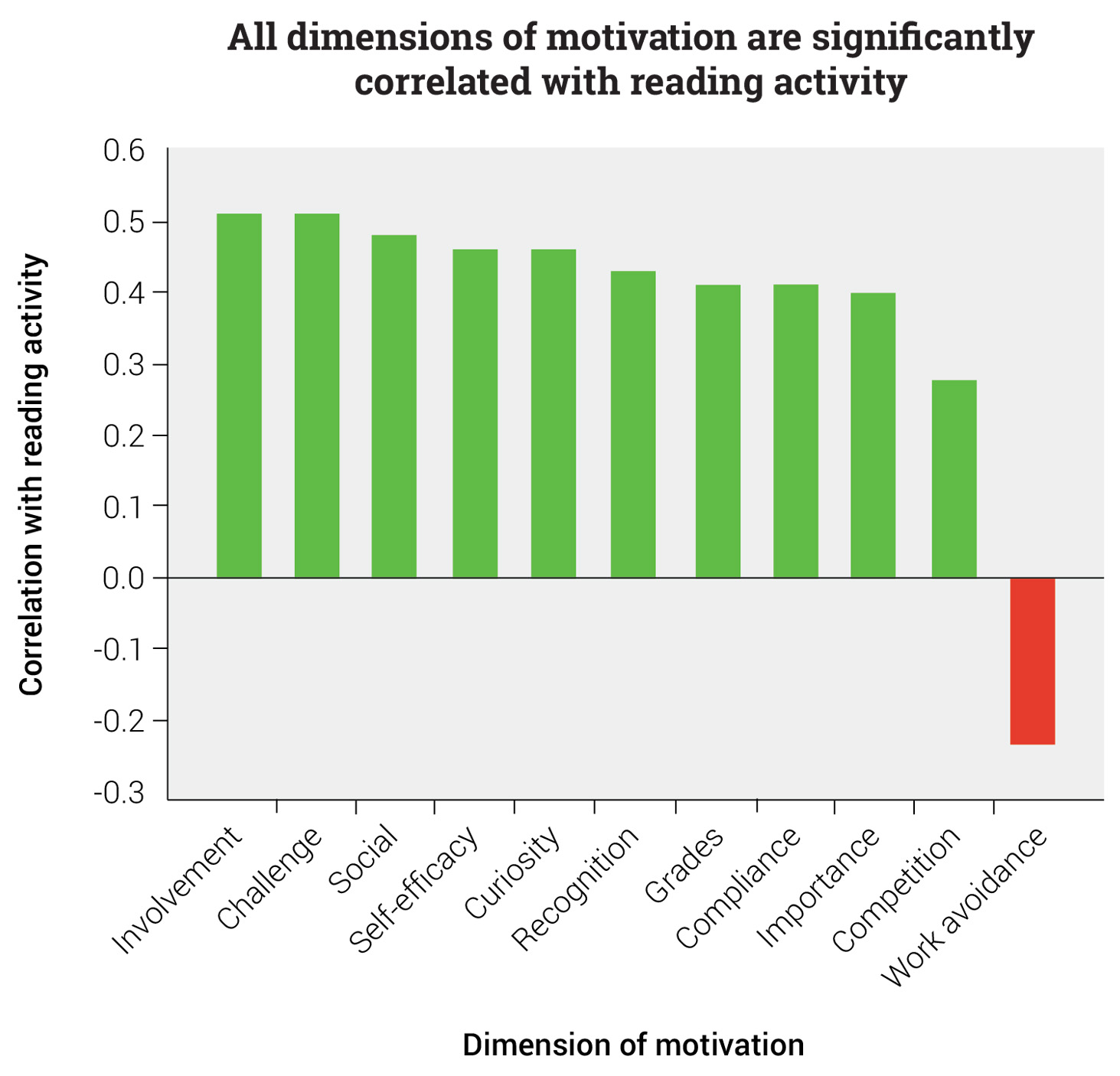
The authors of the study emphasized that reading motivation should be viewed as multifaceted, rather than as a single entity. Students are not simply “motivated” or “not motivated.” They might be motivated in one dimension but not another—and not all dimensions are equal.
Keeping this in mind, a blog post like this one could never hope to provide a comprehensive list of everything that motivates students to read. Instead, for this blog, we’ll narrow our focus to look at what kids say motivates them as a helpful starting point.
Another survey that polled more than 1,700 middle school students in 23 schools—a mix of urban schools and rural/small-city schools—revealed that reading, in and of itself, can be motivating. When students were asked an open-ended question about what they enjoyed most about their reading or language arts classes, reading made up 77% of the reasons provided.6
When the study’s authors organized the responses into categories, the order of popularity was as follows:
- Personal reading (reading for personal reasons such as reading for enjoyment or to learn something new)
- Reading in a social context (reading, or talking about reading, with peers or the teacher)
- Activities related to reading (such as watching a movie after reading the book)
- Reading materials (specific titles or genres)
Many students provided more than one reason, reflecting the multifaceted nature of motivation. For example, personal reading made up 36% of the reasons provided but was mentioned by 41% of students.
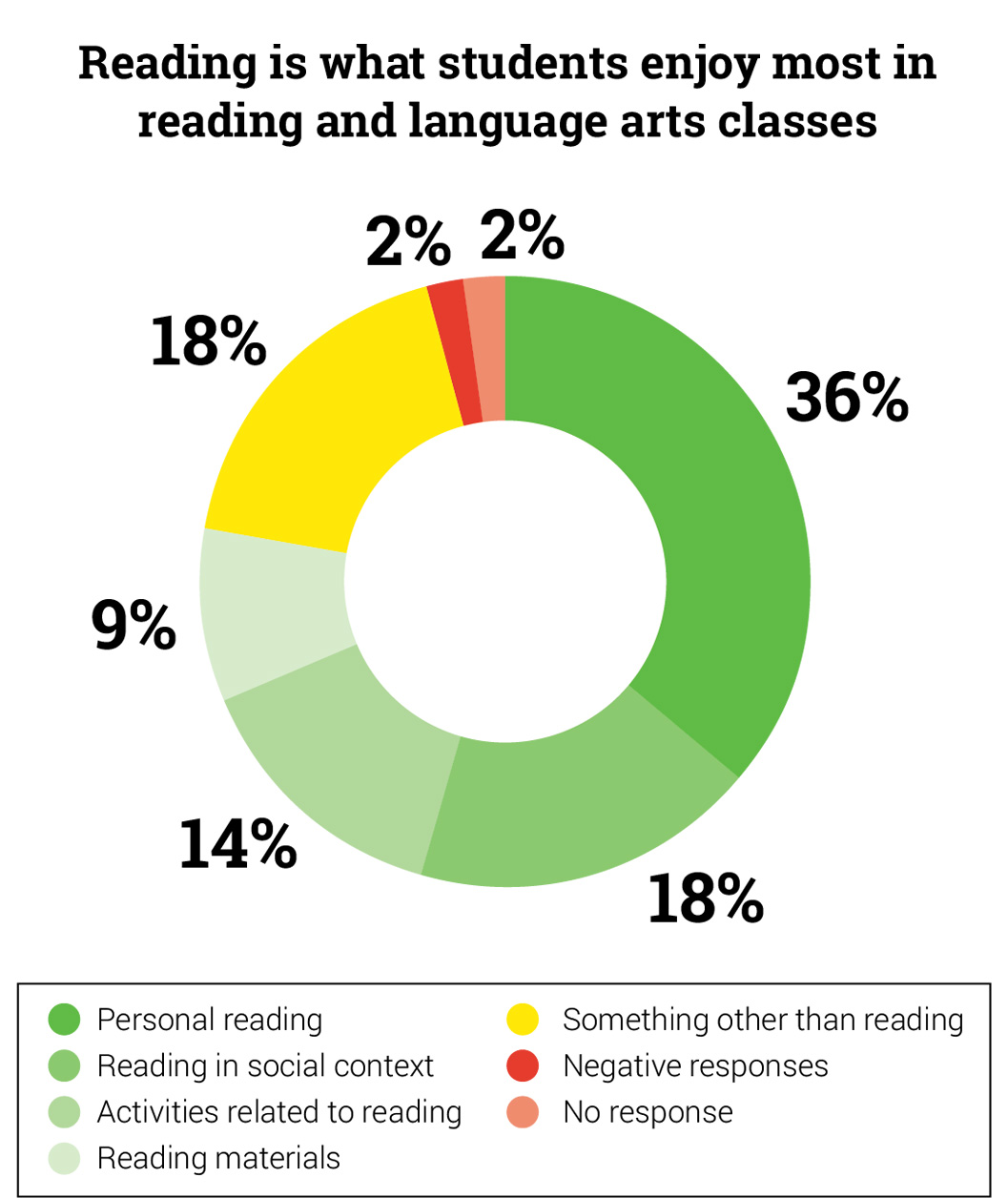
When asked a checklist question about what reading activities they enjoyed most, there were two clear winners: free reading time and the teacher reading out loud.
To a lesser degree, students also enjoyed reading plays and poetry out loud, reading teacher-selected class novels, listening to other students reading out loud, reading with the whole class, and participating in book discussion groups. Students were twice as likely to enjoy reading books they chose (free reading time, 63%) as reading books selected by the teacher (class novels, 31%).
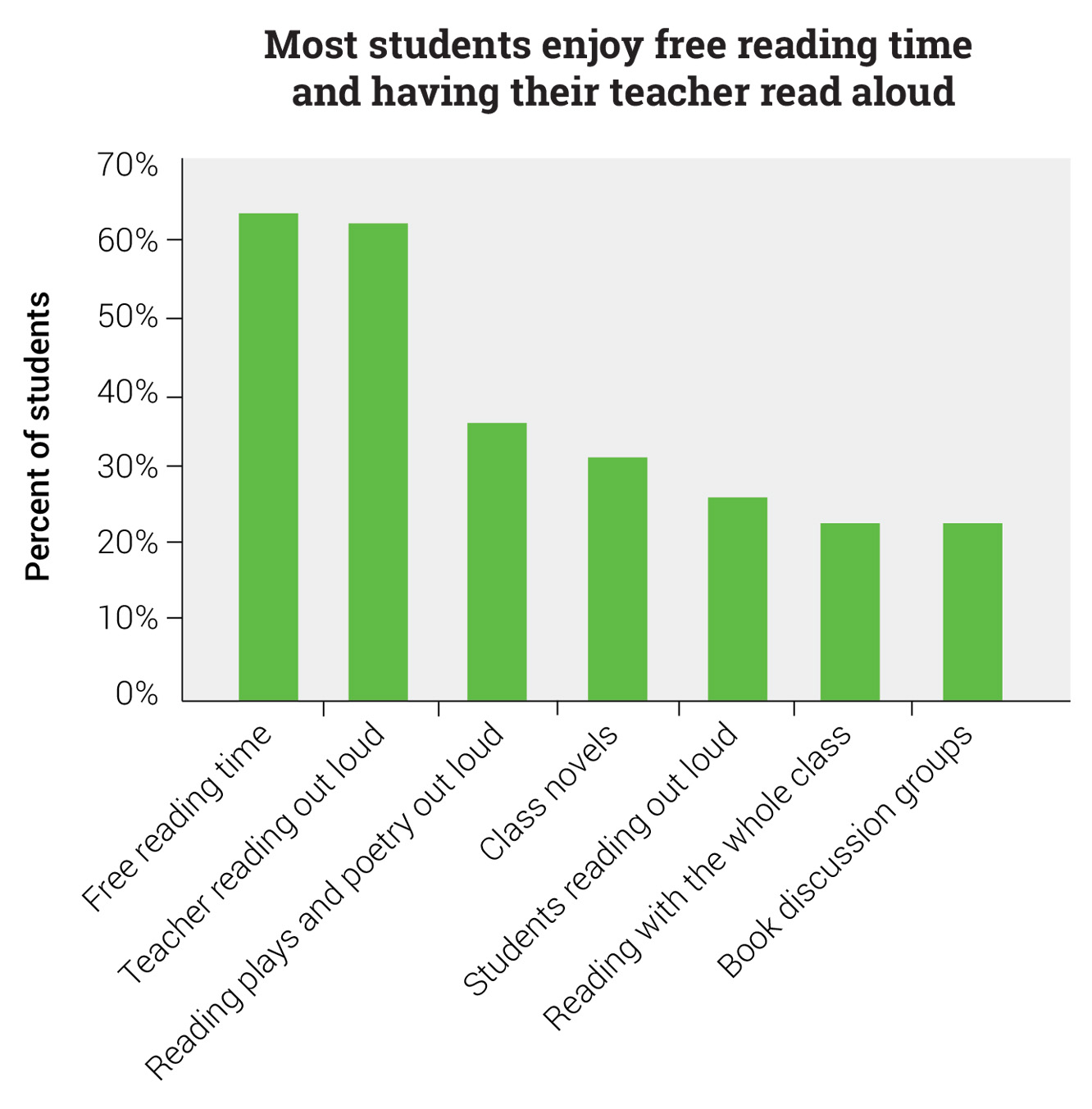
Another open-ended question directly asked students what made them want to read. Once again, motivation was multifaceted, with many students providing more than one reason. The most common was the reading materials themselves. High-quality materials, interesting topics, specific genres and types, and other text-related elements were all factors that made kids want to read.
Personal reasons came next—such as a desire to learn or the desire to enjoy reading as an activity—followed closely by classroom factors, which included a quiet environment for reading and class projects related to reading.
Note that external rewards, including grades and prizes, made up only 6% of total reasons and were mentioned by only 7% of students. The final category was people, which included encouragement from the teacher or discussing texts with peers.
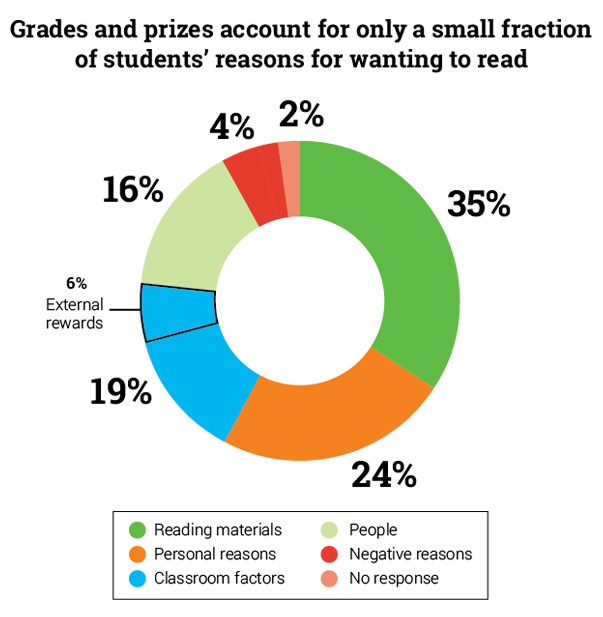
Yet another survey, this one of more than 1,000 children ages 6–17, also found kids had a strong preference for choosing their own reading materials.7 Nearly nine out of ten said their favorite books were the ones they had picked out themselves. A similar number said they were more likely to finish books they had chosen. However, less than two-thirds of children said they usually got to choose which books they read for fun.
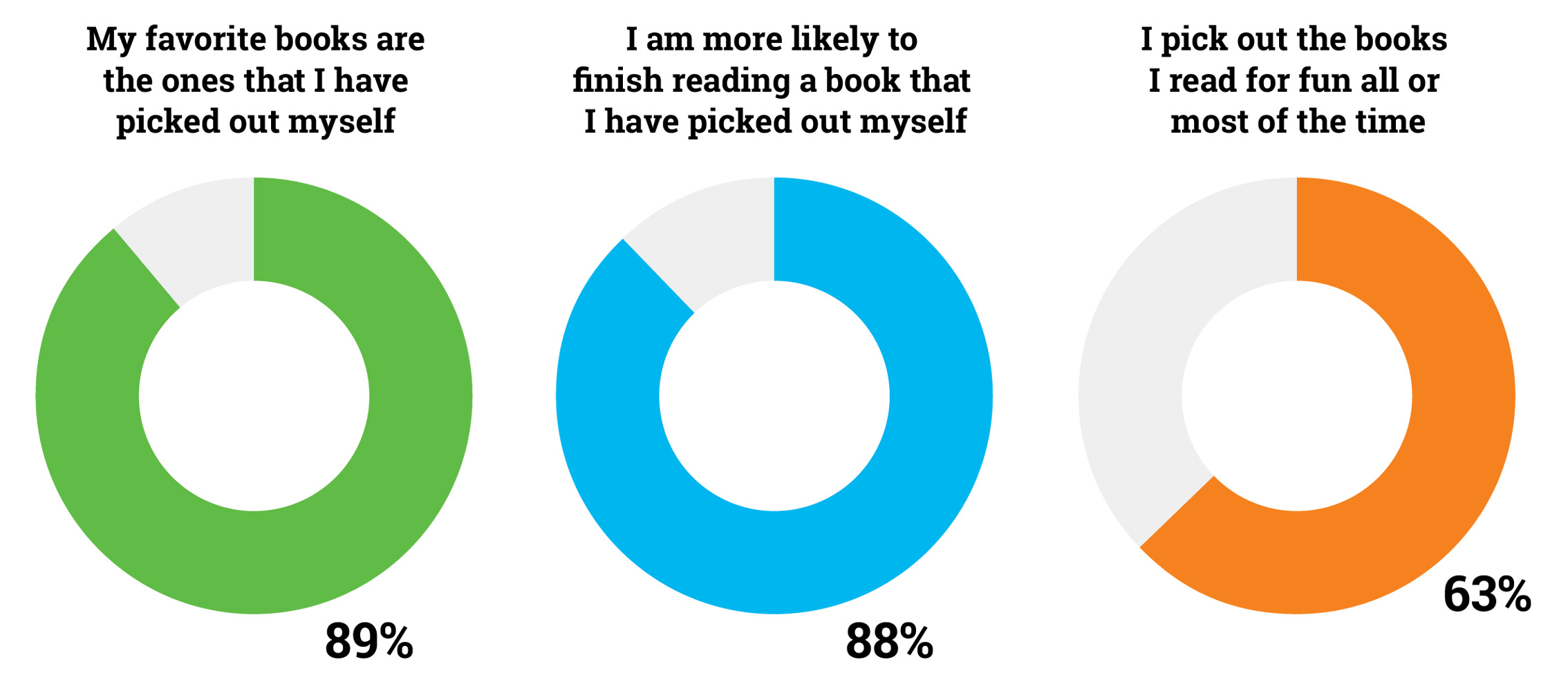
Some students also reported difficulty with finding good reading materials. Three-quarters said they knew they should read more books for fun, and nearly six in ten reported liking or loving reading books for fun. But many had trouble finding books they liked—with the number increasing as children grew older.
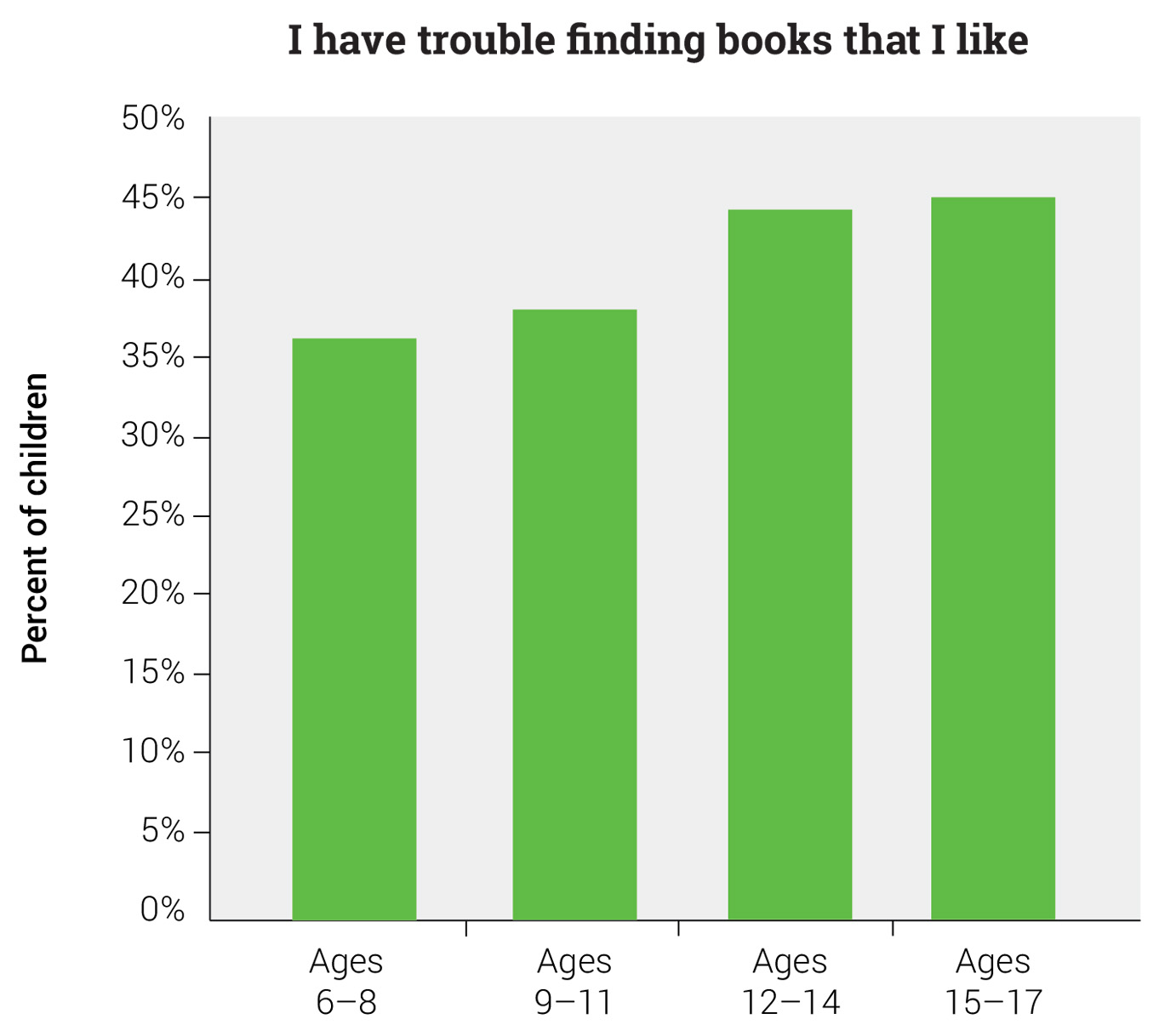
Because “reading materials” was the top response for what made students want to read in the first survey examined, it’s concerning that so many children have trouble finding texts they enjoy. Children reported that educators provided the best ideas about books to read for fun, followed by friends, adult family members, and school book clubs/book fairs.
As educators, we should encourage student choice—and be prepared to offer plenty of options when children struggle to find engaging reading materials. For this reason, we strongly recommend downloading a copy of What Kids Are Reading, which provides lists of the most popular books and articles for each grade based on the reading habits of millions of students across the United States.
In addition, similar to the pattern we saw when examining reader profiles in our third blog post, there was a relationship between a child’s access to reading material at home—specifically books—and the frequency with which they read for fun. Frequent readers had access to more than twice as many books as infrequent readers. From stocking up the library with physical books students can bring home to subscribing to an eBook service students can access from personal or loaned devices, increasing their access to books in school and at home should be a key priority for educators.
4 key takeaways about motivating students to read
- The majority of children find reading and reading-related activities to be enjoyable, so engaging students in reading can, in itself, be motivating.
- The best ways for educators to engage students in reading at school are to set aside time for independent reading and to read aloud to students, as these were the preferred activities by a large margin.
- Giving students access to a wide variety of high-quality texts, connecting reading to students’ personal interests or learning goals, making reading a key part of school and classroom activities, and turning reading into a social activity are good ways to motivate students to read.
- Students should be encouraged to choose their own books and other reading materials, but educators should be prepared to help kids find good book choices.
Set the stage for long-term reading success
Returning to the question we posed at the beginning of this post, the answer now seems clear. How do we motivate struggling readers to engage in that high-quality reading practice? It’s done by:
- Setting personalized goals for reading
- Dedicating time to reading activities
- Providing access to a wide variety of high-quality reading materials
- Supporting student choice
- Socializing reading and making it part of school culture
And by being patient. Just like students, motivation needs time to grow and succeed.
Thus far, we’ve examined reading quantity, reading quality, and reading motivation. In the next entry, we expand our horizons and explore how reading success relates to success in other content areas, such as math and science.
References
1 Wigfield, A., & Guthrie, J. T. (1997). Relations of children’s motivation for reading to the amount and breadth or their reading. Journal of Educational Psychology, 89(3), 420-432.
2 Kush, J. C., Watkins, M. W., & Brookhart, S. M. (2005). The temporal-interactive influence of reading achievement and reading attitude. Educational Research and Evaluation, 11(1), 29-44.
3 Martinez, R. S., Aricak, O. T., & Jewell, J. (2008). Influence of reading attitude on reading achievement: A test of the temporal-interaction model. Psychology in Schools, 45(10), 1010-1023.
4 Renaissance Learning. (2014). What kids are reading: And why it matters. Wisconsin Rapids, WI: Author.
5 Baker, L., & Wigfield, A. (1999). Dimensions of children’s motivation for reading and their relations to reading activity and reading achievement. Reading Research Quarterly, 34(4), 452-477.
6 Ivey, G., & Broaddus, K. (2001). “Just plain reading”: A survey of what makes students want to read in middle school classrooms. Reading Research Quarterly, 36(4), 350-377.
7 Scholastic. (2017). Kids & family reading report. Retrieved from http://www.scholastic.com/readingreport/files/Scholastic-KFRR-6ed-2017.pdf
Interwoven: Achievement in reading, science, and math
To read the next post in this series, click the button below.

